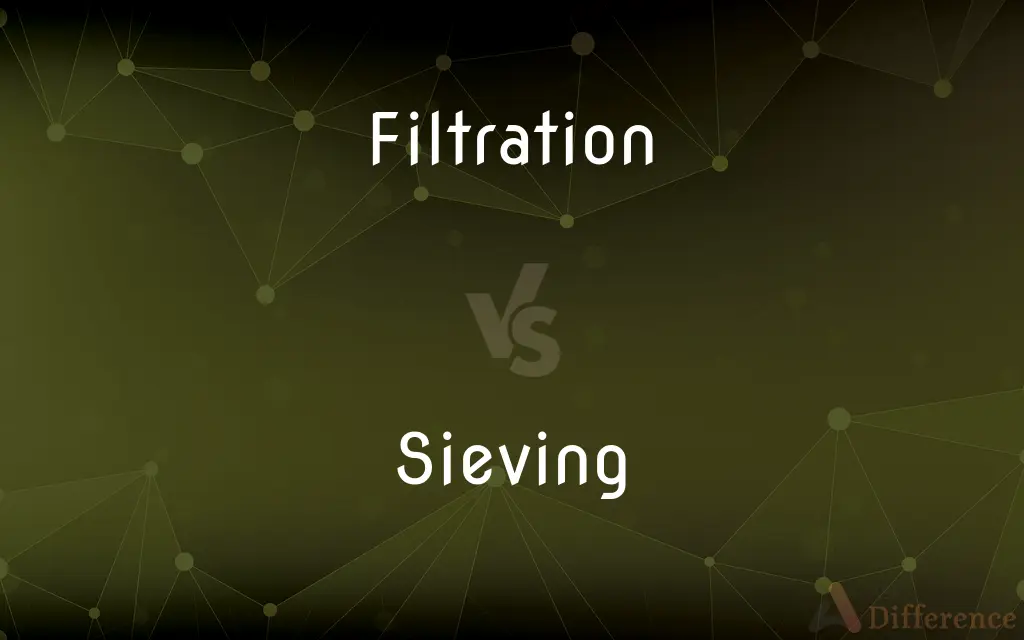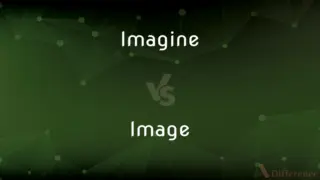Filtration vs. Sieving — What's the Difference?
By Tayyaba Rehman — Updated on October 19, 2023
Filtration separates substances using a porous barrier, often liquid from solids, while sieving segregates particles based on size using a mesh or perforated layer.

Difference Between Filtration and Sieving
Table of Contents
ADVERTISEMENT
Key Differences
Filtration is a separation technique where substances pass through a filter, usually allowing the fluid to flow through while retaining larger particles. Sieving, on the other hand, involves using a sieve, where particles of varying sizes are separated based on their ability to pass through the mesh.
In the context of Filtration, a fluid (either a liquid or gas) is passed through a barrier, like filter paper, that captures unwanted solid particles. In contrast, Sieving relies on a sieve or screen with specific hole sizes to segregate particles based on size alone.
One significant difference between Filtration and Sieving is the nature of the separated components. Filtration often targets the removal of solid particles from a liquid or gas. Sieving primarily deals with separating solids of different sizes from each other.
Filtration can be utilized in advanced scenarios, such as in laboratory procedures where precise separation is required, often involving tiny particles. Sieving is a more straightforward technique commonly found in kitchens and construction sites to separate grains or aggregates.
Comparison Chart
Mechanism
Uses a porous barrier
Uses a mesh or perforated layer
ADVERTISEMENT
Components
Often liquid and solid
Typically solid particles
Precision
Can be very precise
Generally coarser separation
Common Usage
Labs, water purification
Kitchens, construction sites
Particle Interaction
Captures unwanted particles
Segregates based on ability to pass mesh
Compare with Definitions
Filtration
Process to purify or refine a substance.
Filtration ensures safe drinking water.
Sieving
A process to separate particles based on size.
Sieving the flour helps in baking.
Filtration
A method to separate particles from a fluid.
Filtration of the water removed the contaminants.
Sieving
Action of sifting through a mesh.
Sieving is crucial in separating larger nuts from the mix.
Filtration
A technique to prevent unwanted elements.
Filtration systems in pools keep the water clean.
Sieving
Separation based on the ability to pass through openings.
She was Sieving grains to get rid of small stones.
Filtration
Filtration is a physical or chemical separation process that separates solid matter and fluid from a mixture using a filter medium that has a complex structure through which only the fluid can pass. Solid particles that cannot pass through the filter medium are described as oversize and the fluid that passes through is called the filtrate.
Sieving
Using a sieve to segregate components.
They started Sieving the sand to find the lost ring.
Filtration
Removal of solid substances from a liquid or gas.
Air Filtration is essential in car engines.
Sieving
A method to remove lumps or unwanted particles.
Sieving ensures the powder's consistency.
Filtration
The action or process of filtering something
Small particles are difficult to remove without filtration
Sieving
A utensil of wire mesh or closely perforated metal or plastic, used for straining, sifting, ricing, or puréeing.
Filtration
The act or process of filtering.
Sieving
To pass through a sieve.
Filtration
The act or process of filtering; the mechanical separation of a liquid from the undissolved particles floating in it.
Sieving
To use a sieve; sift.
Filtration
A totally ordered collection of subsets.
Sieving
Present participle of sieve
Filtration
The act or process of filtering; the mechanical separation of a liquid from the undissolved particles floating in it.
Sieving
The act of passing something through a sieve.
Filtration
The process whereby fluids pass through a filter or a filtering medium
Sieving
Material that has passed through a sieve.
Filtration
The act of changing a fluid by passing it through a filter
Filtration
The action of filtering impurities.
The lab focuses on advanced Filtration techniques.
Common Curiosities
Can Sieving help in baking?
Yes, Sieving is often used to sift flour and remove lumps in baking.
Can Filtration remove very tiny particles?
Yes, Filtration can be precise enough to remove microscopic particles.
Is Filtration used only with liquids?
No, Filtration can be used with both liquids and gases.
What's the main tool in Sieving?
The main tool in Sieving is a sieve or a screen with specific hole sizes.
Can Sieving separate particles of similar size?
Sieving is most effective for particles with noticeable size differences.
What's a simple example of Sieving?
Using a kitchen strainer to separate pasta from water is a Sieving action.
What's a common household example of Filtration?
A coffee filter separating grounds from liquid coffee demonstrates Filtration.
Can Filtration systems be part of appliances?
Yes, many appliances, like air purifiers or water dispensers, have built-in Filtration systems.
Which is more precise: Filtration or Sieving?
Filtration can be more precise, especially in advanced laboratory settings.
Is Sieving a purely mechanical process?
Generally, yes. It relies on physical barriers and particle sizes.
Are the particles discarded in Sieving?
Not necessarily. Both retained and passed particles can be of interest.
Do all Filtration processes need a filter medium?
Most do, but methods vary from filter papers to membranes and more.
Are there advanced Filtration techniques for labs?
Yes, labs often employ advanced Filtration methods for specific needs.
Is Sieving effective for microscopic particles?
Generally, Sieving is for more substantial, macroscopic particles.
Can Filtration and Sieving be used together?
Absolutely. Some processes might use both for thorough separation.
Share Your Discovery

Previous Comparison
Oregano vs. Ajwain
Next Comparison
Imagine vs. ImageAuthor Spotlight
Written by
Tayyaba RehmanTayyaba Rehman is a distinguished writer, currently serving as a primary contributor to askdifference.com. As a researcher in semantics and etymology, Tayyaba's passion for the complexity of languages and their distinctions has found a perfect home on the platform. Tayyaba delves into the intricacies of language, distinguishing between commonly confused words and phrases, thereby providing clarity for readers worldwide.














































